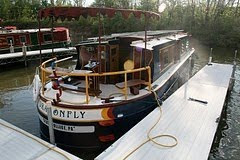 |
| The two-room school where Conroy taught is now a church community center. Lots more pictures HERE |
In the mid 1970s, when the book (and movie) came out, the Cap'n was a young, passionate, unconventional teacher-to-be. He remembers reading the book to be a revolutionary experience.
Turns out, "Yamacraw" is a pseudonym for real-life Dafuskie Island . . . and we docked there Monday. (Photos HERE!) Dafuskie (Gullah for Da fus' key, "The First Key,") is a bit north of Savannah--just past Hilton Head.
The Gullah people are freed blacks who, after "The War of Northern Oppression," were re-settled on the sea islands of Georgia and South Carolina, where plantations were divided up into small farms.
These island residents, descended from people enslaved from Sierra Leone, have, in their isolation, preserved more of their original culture than any other African-American group--including their distinctive dialect. His first day in the classroom, Conroy says, he could barely understand his students.
 |
| Conroy and his students played a lot of basketball. |
Conroy arrived on Dafuskie shortly after America sent men to the moon. But many modern innovations hadn't reached the island. It had dirt roads, no phones, no fire department, no hospital or clinic. There was one car; islanders got around mostly by oxcart. They made their living catching shrimp, fish, and oysters in small boats.
Today many of the roads are still surfaced with pale sand. Traveling down them, you can still see some of the tiny vernacular cottages, with their deep porches and sheet metal roofs, tucked under massive live oaks, with goats and dogs roaming the yards.
As I biked one muddy track, under a canopy of live oaks and palms, I spotted a tree covered with bright red flowers: a red maple, ready for spring. Flocks of warblers peeped quietly in the undergrowth, systematically refueling on their northbound migration.
Meanwhile the boat landing had rows of contractor's pickups and vans, and island traffic--a mix of golf carts and high-end SUVs-- whisked down the lone paved road that runs the length of the island. Developers bought land here in the 70s and 80s. Two tracts of land, formerly cotton plantations, are now gated communities sprouting expensive houses. The northern tip of the island has a row of brand new mansions, each as elaborate as the Jekyll Island Club for millionaires--next to a shaggy, dry brown golf course, bankrupt and abandoned.
 |
| An old home made new. |
The challenges for Dafuskie Island: How to give residents stable jobs that pay a living wage, how to make sure the community has basic services . . . without destroying the island's cultural heritage and natural beauty. Without destroying the special things that give it sense of place, and the valuable ecosystems that support native species.
I guess that's the challenge our nation faces pretty much everywhere.





No comments:
Post a Comment